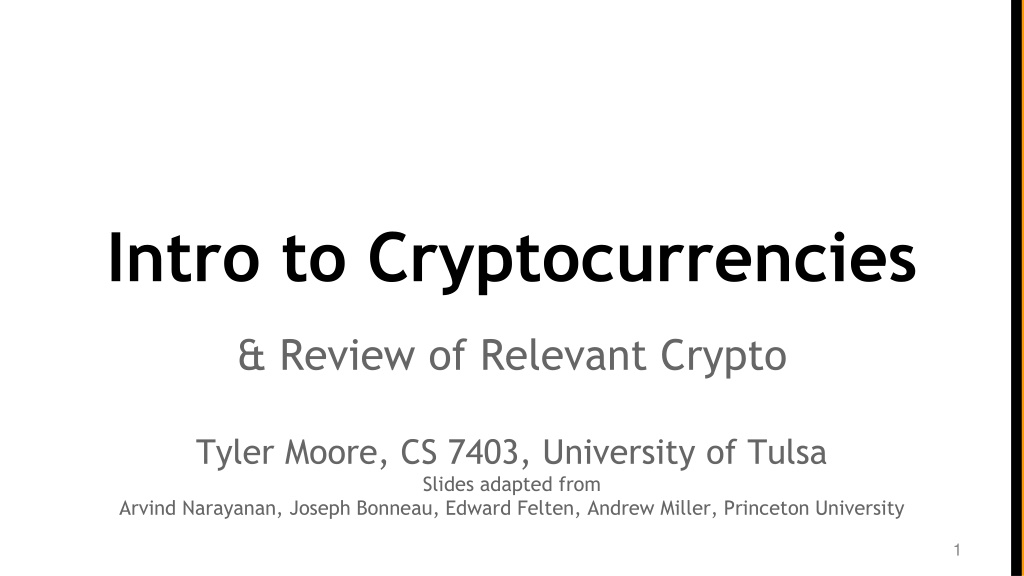
Understanding Cryptographic Hash Functions and Properties
Learn about cryptographic hash functions, hash properties, collisions, and their applications in cryptocurrencies. Explore how hash functions ensure collision-free and hiding properties for secure data handling.
Download Presentation

Please find below an Image/Link to download the presentation.
The content on the website is provided AS IS for your information and personal use only. It may not be sold, licensed, or shared on other websites without obtaining consent from the author. If you encounter any issues during the download, it is possible that the publisher has removed the file from their server.
You are allowed to download the files provided on this website for personal or commercial use, subject to the condition that they are used lawfully. All files are the property of their respective owners.
The content on the website is provided AS IS for your information and personal use only. It may not be sold, licensed, or shared on other websites without obtaining consent from the author.
E N D
Presentation Transcript
Intro to Cryptocurrencies & Review of Relevant Crypto Tyler Moore, CS 7403, University of Tulsa Slides adapted from Arvind Narayanan, Joseph Bonneau, Edward Felten, Andrew Miller, Princeton University 1
Overview Cryptographic Hash Functions Hash Pointers and Data Structures Digital Signatures Public Keys as Identities Simple Cryptocurrencies 2
Overview Cryptographic Hash Functions Hash Pointers and Data Structures Digital Signatures Public Keys as Identities Simple Cryptocurrencies 3
Hash function: takes any string as input fixed-size output (we ll use 256 bits) efficiently computable Security properties: collision-free hiding puzzle-friendly 4
Hash property 1: Collision-free Nobody can find x and y such that x != y and H(x)=H(y) x H(x) = H(y) y 5
Collisions do exist ... possible outputs possible inputs but can anyone find them? 6
How to find a collision try 2130randomly chosen inputs 99.8% chance that two of them will collide This works no matter what H is but it takes too long to matter 7
Is there a faster way to find collisions? For some possible H s, yes. For others, we don t know of one. No H has been proven collision-free. 8
Application: Hash as message digest If we know H(x) = H(y), it s safe to assume that x = y. To recognize a file that we saw before, just remember its hash. Useful because the hash is small. 9
Hash property 2: Hiding We want something like this: Given H(x), it is infeasible to find x. H( heads ) easy to find x! H( tails ) 10
Hash property 2: Hiding Hiding property: If r is chosen from a probability distribution that has high min-entropy, then given H(r | x), it is infeasible to find x. High min-entropy means that the distribution is very spread out , so that no particular value is chosen with more than negligible probability. 11
Application: Commitment Want to seal a value in an envelope , and open the envelope later. Commit to a value, reveal it later. 12
Commitment API (com, key) := commit(msg) match := verify(com, key, msg) To seal msg in envelope: (com, key) := commit(msg) -- then publish com To open envelope: publish key, msg anyone can use verify() to check validity 13
Commitment API (com, key) := commit(msg) match := verify(com, key, msg) Security properties: Hiding: Given com, infeasible to find msg. Binding: Infeasible to find msg != msg such that verify(commit(msg), msg ) == true 14
Commitment API commit(msg) := ( H(key | msg), H(key) ) where key is a random 256-bit value verify(com, key, msg) := ( H(key | msg) == com ) Security properties: Hiding: Given H(key | msg), infeasible to find msg. Binding: Infeasible to find msg != msg such that H(key | msg) == H(key | msg ) 15
Hash property 3: Puzzle-friendly Puzzle-friendly: For every possible output value y, if k is chosen from a distribution with high min-entropy, then it is infeasible to find x such that H(k | x) = y. 16
Application: Search puzzle Given a puzzle ID id (from high min-entropy distrib.), and a target set Y: Try to find a solution x such that H(id | x) Y. Puzzle-friendly property implies that no solving strategy is much better than trying random values of x. 17
Overview Cryptographic Hash Functions Hash Pointers and Data Structures Digital Signatures Public Keys as Identities Simple Cryptocurrencies 18
hash pointer is: * pointer to where some info is stored, and * (cryptographic) hash of the info if we have a hash pointer, we can * ask to get the info back, and * verify that it hasn t changed 19
H( ) (data) will draw hash pointers like this 20
key idea: build data structures with hash pointers 21
linked list with hash pointers = block chain H( ) prev: H( ) prev: H( ) prev: H( ) data data data use case: tamper-evident log 22
detecting tampering H( ) prev: H( ) prev: H( ) prev: H( ) data data data use case: tamper-evident log 23
binary tree with hash pointers = Merkle tree H( ) H( ) H( ) H( ) H( ) H( ) H( ) H( ) H( ) H( ) H( ) H( ) H( ) H( ) (data) (data) (data) (data) (data) (data) (data) (data) 24
proving membership in a Merkle tree show O(log n) items H( ) H( ) H( ) H( ) H( ) H( ) (data) 25
Advantages of Merkle trees Tree holds many items but just need to remember the root hash Can verify membership in O(log n) time/space Variant: sorted Merkle tree can verify non-membership in O(log n) (show items before, after the missing one) 26
More generally ... can use hash pointers in any pointer-based data structure that has no cycles 27
Overview Cryptographic Hash Functions Hash Pointers and Data Structures Digital Signatures Public Keys as Identities Simple Cryptocurrencies 28
What we want from signatures Only you can sign, but anyone can verify Signature is tied to a particular document can t be cut-and-pasted to another doc 29
API for digital signatures (sk, pk) := generateKeys(keysize) sk: secret signing key pk: public verification key sig := sign(sk, message) isValid := verify(pk, message, sig) 30
Requirements for signatures valid signatures verify verify(pk, message, sign(sk, message)) == true can t forge signatures adversary who: knows pk gets to see signatures on messages of his choice can t produce a verifiable signature on another message 31
Note: Bitcoin uses ECDSA standard Elliptic Curve Digital Signature Algorithm relies on hairy math will skip the details here --- look it up if you care good randomness is essential foul this up in generateKeys() or sign() ? probably leaked your private key 32
Overview Cryptographic Hash Functions Hash Pointers and Data Structures Digital Signatures Public Keys as Identities Simple Cryptocurrencies 33
Useful trick: public key == an identity if you see sig such that verify(pk, msg, sig)==true, think of it as pk says, [msg] . to speak for pk, you must know matching secret key sk 34
How to make a new identity create a new, random key-pair (sk, pk) pk is the public name you can use [usually better to use Hash(pk)] sk lets you speak for the identity you control the identity, because only you know sk if pk looks random , nobody needs to know who you are 35
Decentralized identity management anybody can make a new identity at any time make as many as you want! no central point of coordination These identities are called addresses in Bitcoin. 36
Privacy Addresses not directly connected to real-world identity. But observer can link together an address s activity over time, make inferences. 37
Overview Cryptographic Hash Functions Hash Pointers and Data Structures Digital Signatures Public Keys as Identities Simple Cryptocurrencies 38
GoofyCoin 39
Goofy can create new coins New coins belong to me. signed by skGoofy CreateCoin [uniqueCoinID] 40
A coins owner can spend it. Alice owns it now. signed by skGoofy Pay to pkAlice: H( ) signed by skGoofy CreateCoin [uniqueCoinID] 41
The recipient can pass on the coin again. signed by skAlice Bob owns it now. Pay to pkBob: H( ) signed by skGoofy Pay to pkAlice: H( ) signed by skGoofy CreateCoin [uniqueCoinID] 42
double-spending attack signed by skAlice signed by skAlice Pay to pkBob: H( ) Pay to pkChuck: H( ) signed by skGoofy Pay to pkAlice: H( ) signed by skGoofy CreateCoin [uniqueCoinID] 43
double-spending attack one of the main design challenges in digital currencies 44
ScroogeCoin 45
Scrooge publishes a history of all transactions (a block chain, signed by Scrooge) H( ) prev: H( ) transID: 71 prev: H( ) transID: 72 prev: H( ) transID: 73 trans trans trans 46 optimization: put multiple transactions in the same block
CreateCoins transaction creates new coins Valid, because I said so. transID: 73 type:CreateCoins coins created value recipient num coinID 73(0) 0 3.2 0x... coinID 73(1) 1 1.4 0x... coinID 73(2) 2 7.1 0x... 47
PayCoins transaction consumes (and destroys) some coins, and creates new coins of the same total value transID: 73 type:PayCoins consumed coinIDs: 68(1), 42(0), 72(3) Valid if: -- consumed coins valid, -- not already consumed, -- total value out = total value in, and -- signed by owners of all consumed coins coins created value recipient num 0 3.2 0x... 1 1.4 0x... 2 7.1 0x... signatures 48
Immutable coins Coins can t be transferred, subdivided, or combined. But: you can get the same effect by using transactions to subdivide: create new trans consume your coin pay out two new coins to yourself 49
Dont worry, Im honest. Crucial question: Can we descroogify the currency, and operate without any central, trusted party? 50









![101 Reviews How to Recover Lost Bitcoin [Scammed/Stolen Funds]](/thumb/153354/101-reviews-how-to-recover-lost-bitcoin-scammed-stolen-funds.jpg)












